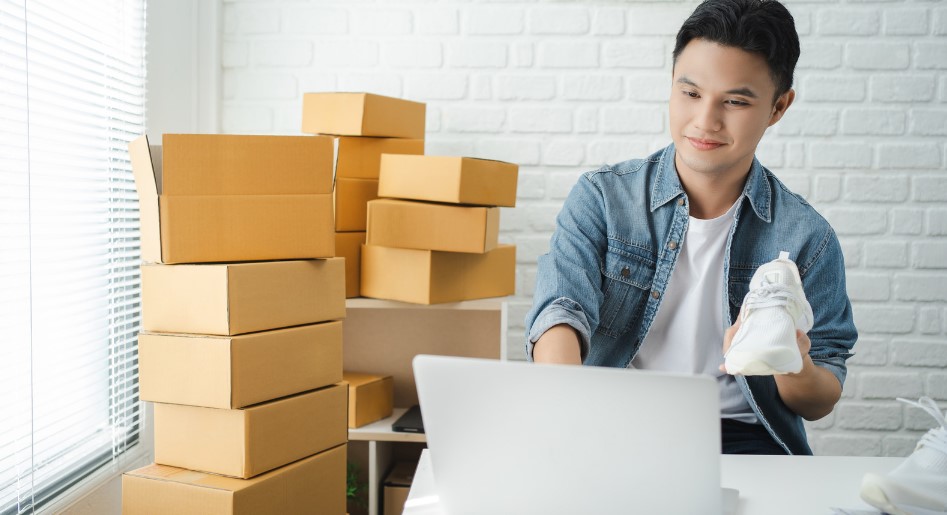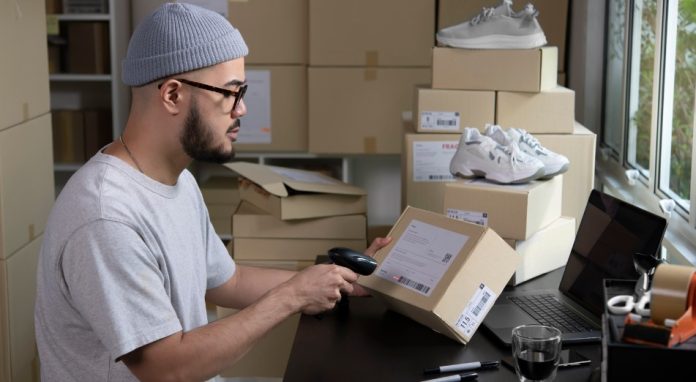Table of Contents
Whether performed in-house, or outsourced via a third-party logistics provider (3PL), picking and packing is the art of efficient order processing, where both speed and accuracy count.
While picking is the task of collecting a product from a picking location, which can be from a pallet space or shelf, packing is the procedure of putting a product into a parcel, or amalgamating multiple products together, ready for application of the shipping label and injection into the courier networks.
In this article we will discuss the pros and cons of conducting order processing in-house, versus outsourcing eCommerce fulfilment with a 3PL.
What is eCommerce Fulfilment?
It’s the high-trust process online retailers take, of entrusting a specialist company to manage the goods intake, storage, picking, packing, and distribution on their behalf, as their brand. Demand for 3PL fulfilment is skyrocketing, and over the next decade, the eCommerce warehousing market is set to more than triple in size.
Because of this market growth, the battleground is fertile, yet competition is intense, which has led to 3PLs increasingly offering complementary services, such as cross-border customs clearance, bespoke packaging, outsourced customer service, strategy and procurement consultancy.
In the case of Zendbox, this UK fulfilment centre provides clients with inventory analysis technology, to help its clients, who are retail decision-makers, avoid overstocking and understocking. While overstocking can lead to capital tied up in inventory that could be better utilised elsewhere, understocking leads to missed sales. Therefore, getting inventory control right can help eCommerce enterprises maximise sales, whilst minimising capital misallocation.
What Are the Benefits of Picking and Packing in-house?
Outsourcing order fulfilment isn’t right for all businesses, particularly start-ups. This is because 3PLs usually demand a minimum average daily order volume of between 10 and 30 shipments.
Fulfilment centres that specialise in mid-market and major global online brands often demand 300 as a minimum. This is so that both parties have reached the required economies of scale to achieve a profitable business relationship. For smaller sellers shipping less than 10 orders per day, there are dedicated ad-hoc delivery providers, who can perform single daily collections across multiple carriers.
For retailers who are shipping high order volumes, but who would like to retain their order fulfilment in-house, there are multi-carrier shipping aggregators who can assist.
Retaining order fulfilment in-house gives retailers greater control, but this does mean leadership might get over-involved in the day-to-day business operations, focusing less on strategy, vision, sales, marketing, new product development and competitor analysis.
How Do 3PL Services Work?
Outsourcing order fulfilment begins with finding the right supplier. Checking third-party client and employee reviews, along with case studies is a sensible starting approach, as is ensuring the 3PL integrates with your eCommerce platform (e.g. Shopify, WooCommerce or Magento), marketplaces and/or order management system (OMS).

Pricing can be hideously complex, and involves a storage and picking fees, packing and shipping charges, up-front and ongoing onboarding, integration and software costs. Furthermore, additional costs can be associated with the 3PL’s complementary services such as product and shipping-related customer query management.
Fulfilment warehouses typically specialise in multiple product verticals, but the majority are more flexible and work with everything from homewares, to clothing, to sports nutrition, health and wellness product categories.
Once you’ve found the right 3PL for your needs, the next step is to establish KPIs with them (key performance indicators) and OKRs (objectives and key results), to ensure both retailer and eCommerce logistics provider are aligned in their expectations of what good, and excellent performance constitutes. Metrics could include order processing speed, on-time delivery performance, WISMOs (‘Where is my order?’ queries), and customer feedback scores in the form of CSAT and NPS.
Once the contract is signed, the next stage is to establish lines of communication, roles, responsibilities, and key deliverables across both parties, such as instructing manufacturers and suppliers of the new fulfilment warehouse location, to send inventory to, and introducing the warehousing team to the client. When systems are integrated, orders can begin flowing in.
As an online shopper places an order, a picking and packing note is generated, which is passed from the client’s sales channels, to the 3PL’s warehouse management system (WMS). This instructs the picking team where to collect the product from, from within the warehouse, while the packing team receives packaging instructions.
At this point, the shipping label is also generated, and applied to the parcel at the packing bench. After this, shipments are grouped by UK and international carrier partners (e.g. DHL, DPD, FedEx and UPS), ready for collection by the courier. The later the carrier collection is allowed to happen, the more customers are able to select next-day delivery options at checkout.
This depends on the 3PL’s relationship with courier partners, but in the case of a certain UK fulfilment centre, they learned that a late order cut-off time is a major competitive advantage, proven to increase eCommerce conversion rates, customer loyalty, and revenue.
With 35% of online orders placed between 4pm and 9pm, the UK 3PL introduced a 10pm order cut-off time, helping merchants offer next-day delivery to more consumers. As a result, clients experienced an average conversion rate increase of 15%, as detailed in this eCommerce fulfilment case study video:
The Future of Pick and Pack Services
With tremendous growth anticipated, it’s safe to assume that picking and packing warehouse operatives will have plenty of work for the foreseeable future. The big challenge will be more for retailers and 3PLs alike, who will face increasing pressure from competitors, and from fussy consumers who demand fast, free, yet environmentally-friendly shipping, and items to never be out of stock.
They expect increasingly sophisticated in-flight delivery options, the ability to customise their orders, and want to be rewarded for their loyalty. Ecommerce leaders must never ignore the value of the human touch, despite increasing pressure to drive efficiency gains through AI and IoT, and those that can balance both capabilities, whilst delivering a leading-edge customer experience, will reign supreme.

